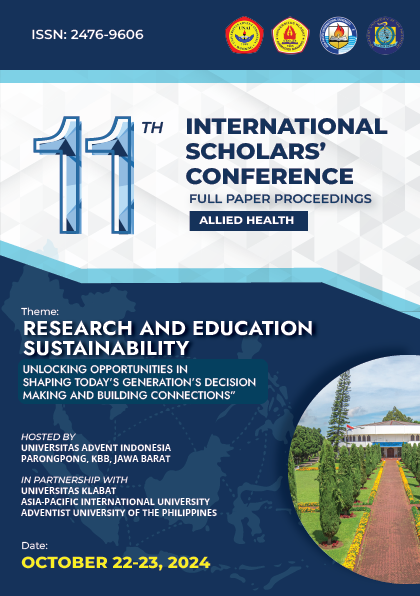Nutrient Adequacy and Body Mass Index of Working College Students
Keywords:
BMI, Working College Students, Nutrient Adequacy, Physical Activity, Boarding TypeAbstract
Proper nutrition is essential for human growth, development, and overall well-being, yet working college students often face unique challenges that can lead to inadequate dietary intake. This descriptive study assesses the nutrient adequacy and Body Mass Index (BMI) of 42 working students from a university in Cavite, Philippines. Nutrient adequacy, focusing on carbohydrates, proteins, and fats, was evaluated using a 3-day dietary record, while BMI was calculated based on anthropometric measurements. The results showed that most students had inadequate intakes of carbohydrates and proteins, with only fat intake meeting recommended levels. BMI analysis revealed that 74% of participants had normal weight, 14% were underweight, and 12% were overweight or obese. While no significant differences in nutrient adequacy were observed based on sex or boarding type, significant differences were found across physical activity levels, with those engaging in heavier activities exhibiting lower nutrient adequacy. These findings underscore the need for nutritional interventions tailored to the needs of working students, particularly those with high physical activity demands.
Downloads
References
Abraham, S., Noriega, B. R., & Shin, J. Y. (2018). College students eating habits and knowledge of nutritional requirements. Journal of Nutrition and Human Health, 2(1), 13-17. https://doi.org/10.35841/nutrition-human-health.2.1.13-17
Bier, D. M., Derelian, D., German, J. B., Katz, D. L., & Maughan, R. J. (2015). Nutritional issues in college students: A call for nutrition awareness and guidance in higher education. Nutrition Today, 50(1), 14-21. https://doi.org/10.1097/NT.0000000000000072
British Nutrition Foundation. (2012). Nutrient requirements. https://www.nutrition.org.uk/attachments/article/234/Nutrient_requirements.pdf
Centers for Disease Control and Prevention. (2017). About adult BMI. https://www.cdc.gov/healthyweight/assessing/bmi/adult_bmi/index.html
Das, M., & Evans, R. (2014). The role of employment in student diet and health. Public Health Reports, 129(1), 35-44. https://doi.org/10.1177/003335491412900106
Food and Nutrition Research Institute - Department of Science and Technology (FNRI-DOST). (2013). 8th National Nutrition Survey: Philippines. https://www.fnri.dost.gov.ph/images/sources/NutritionFactsandFigures2013.pdf
Food and Nutrition Research Institute - Department of Science and Technology (FNRI-DOST). (2015). Philippine Dietary Reference Intakes 2015. https://www.fnri.dost.gov.ph/images/images/philippine_dietary_reference_intakes_pdr.pdf
Gan, W. Y., Mohd Nasir, M. T., Zalilah, M. S., & Hazizi, A. S. (2011). Disordered eating behaviors, depression, anxiety and stress among Malaysian university students. College Student Journal, 45(2), 296-310.
Gorgulho, B., Marchioni, D. M., Conceição, A. B., Steluti, J., Mussi, M. H., & Fischer, F. M. (2012). Quality of diet of working college students. Work, 41(1), 5806-5808. https://doi.org/10.3233/WOR-2012-0958-5806
Harvard School of Public Health. (2018). The nutrition source: Fats and cholesterol. https://www.hsph.harvard.edu/nutritionsource/what-should-you-eat/fats-and-cholesterol/
Jéquier, E. (1994). Carbohydrates as a source of energy. The American Journal of Clinical Nutrition, 59(3), 682S-685S. https://doi.org/10.1093/ajcn/59.3.682S
Patton-Lopez, M. M., Lopez-Cevallos, D. F., Cancel-Tirado, D. I., & Vazquez, L. (2014). Prevalence and correlates of food insecurity among students attending a midsize rural university in Oregon. Journal of Nutrition Education and Behavior, 46(3), 209-214. https://doi.org/10.1016/j.jneb.2013.10.007
Peltzer, K., Pengpid, S., Samuels, T. A., Ozcan, N. K., Mantilla, C., Rahamefy, O. H., Gasparishvili, A., & Gasparishvili, A. (2014). Prevalence of overweight/obesity and its associated factors among university students from 22 countries. International Journal of Environmental Research and Public Health, 11(7), 7425-7441. https://doi.org/10.3390/ijerph110707425
World Health Organization (WHO). (2006). BMI classification. http://apps.who.int/bmi/index.jsp?introPage=intro_3.html
World Health Organization (WHO). (2017). Double burden of malnutrition. https://www.who.int/nutrition/double-burden-malnutrition/en/
World Health Organization (WHO). (2018). Global Physical Activity Questionnaire (GPAQ). https://www.who.int/ncds/surveillance/steps/GPAQ_EN.pdf
Yan, Y., Drenowatz, C., Hand, G. A., Shook, R. P., Hurley, T. G., Hébert, J. R., & Blair, S. N. (2016). Is nutrient intake associated with physical activity levels in healthy young adults? Public Health Nutrition, 19(11), 1983-1989. https://doi.org/10.1017/S1368980015003717
Downloads
Published
How to Cite
Issue
Section
License
Copyright (c) 2024 11th International Scholars Conference

This work is licensed under a Creative Commons Attribution-ShareAlike 4.0 International License.
Copyright © 2024 ISC Committee.














